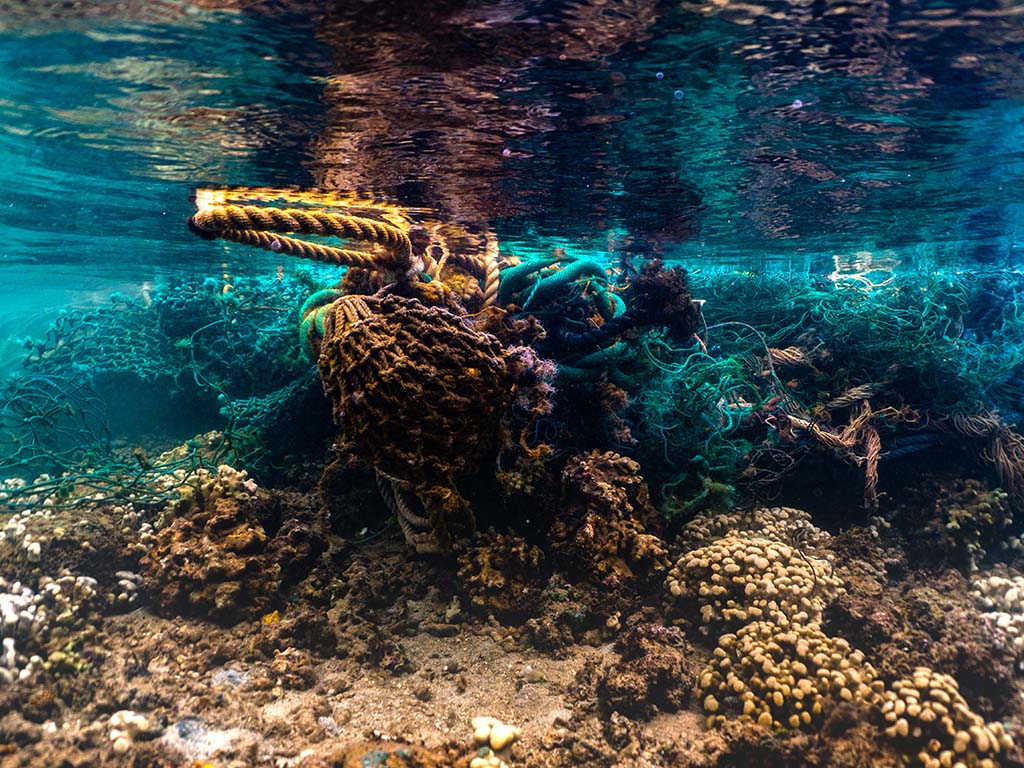
Discarded fishing gear, mostly made of plastic, poses a serious problem in the North Pacific Ocean. Image By Rachel Sandquist .
In a collaborative effort, HPU Center for Marine Debris Research (CMDR) staff, faculty, and one graduate student have contributed to two companion scientific articles in the journal Marine Pollution Bulletin. The titles are, “Large floating abandoned, lost or derelict fishing gear (ALDFG) is frequent marine pollution in the Hawaiian Islands and Palmyra Atoll ” and, “Polymer identification of floating derelict fishing gear from Oʻahu, Hawaiʻi.” Both were published in September 2023.
The articles detail how discarded fishing gear (DFG), which is mostly made of plastic, poses a serious problem in the North Pacific Ocean, causing harmful effects to the environment and economic losses. The first article on ALDFGs documented the frequency, types, and impacts of DFG on Hawaiʻi and Palmyra Atoll over a period of 11 years. Researchers from CMDR, The Nature Conservancy, and Papahānaumokuākea Marine Debris Project, removed and studied a total of 253 DFG events, for a total of 15 metric tons of gear. This included nets, lines, floats, traps, rafts, other fishing device components, and other entangled debris. Depending on the region studied and sampling methods used, the majority of events were made up of either conglomerates – masses of tangled nets, lines, and debris – or a specific type of gear used by the tropical tuna purse seine fishing industry, called drifting fish aggregating devices (dFADs).
Most of the gear found in Hawaiʻi and on Palmyra Atoll did not come from Hawaiian-based fisheries; winds and currents brought it to Hawaiʻi from other fisheries around the Pacific Ocean and the threat and impact to Hawaiian marine life and ecosystems are severe. This research resulted in the largest known database of systematically documented DFG events, which will continue to inform and improve CMDR’s research, removal of DFG from around the Hawaiian Islands, and work on prevention of DFG pollution at the source.
In the second paper, “Polymer identification of floating derelict fishing gear from Oʻahu, Hawaiʻi,” researchers examined the structure and chemical makeup of eight different gear types collected near Oʻahu. They found that after taking apart the gear and identifying the types of plastics used and materials present, 26 different plastic polymers or blends of polymers were present. Identifying the makeup of DFG has important implications both for tracing DFG back to its source as well as making the best use of materials in recycling. Most DFG samples included various forms of polyethylene, a tough synthetic resin that is also used for constructing plastic bags, food containers and other packaging.
Based on the results from this study, the researchers can visually identify the chemical makeup of certain types of gear, without needing to do chemical analysis in the lab. For example, twisted/braided nets made of monofilament fibers are always made of HDPE. Since these can be visually identified and make up a large portion of the DFG found in Hawaiʻi, they can be easily separated and set aside in the field for recycling. CMDR is also working on testing various methods for recycling this type of HDPE net to be reused for local infrastructure purposes.
To learn more about CMDR, click here.


